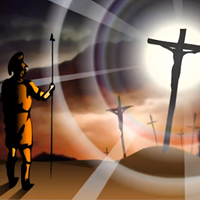The gospels themselves are inspired interpretations of the meaning of the life, death and resurrection of Jesus Christ arising from the earliest experiences of believers in Jesus Christ.
A BRIEF WORD ABOUT THE GOSPELS
Through all ages of the Church they stand as documents which Christians will read, study, pray over and apply to their own lives and situations, and through which God will speak to them. As such they are rightly called ‘the Word of God’.
As foundational documents of the Church they also stand as a reference point against which Christians may judge the authenticity of their lives as Christians and the extent to which the Church is fulfilling its call.
The Introduction to the Gospel of Matthew
The visual introduction to Matthew invites you to focus on the mountain motif in Matthew in introducing its main themes. Matthew was interesting in revealing Jesus as the new Moses and the longed for Messiah.
The Introduction to the Gospel of Luke
The visual introduction to Luke’s gospel uses the reading from Isaiah ‘The Spirit of the Lord is upon me….’ that Jesus quotes during a service in the Synagogue at Nazareth at the beginning of his public ministry ( Luke 4:16-21) as a key to the interpretation of this Gospel. More references to the Holy Spirit are found in Luke than in Matthew and Mark combined hence the choice of this scene as a key to the Gospel.
The Introduction to the Gospel of Mark
Since the question of Jesus’ identity is critical in the gospel of Mark, this visual introduction to the gospel uses the question ‘Who is this man?’ as a stimulus to thinking about the themes of this gospel.
The Introduction to the Gospel of John
A characteristic of John’s gospel is the proclamation of Jesus as the incarnate Son of God. From its magnificent prologue whose opening words match the opening words of the Pentateuch, to its concluding words urging faith in Jesus as the Christ, the Son of God, the Gospel of John has as its central focus the revelation that in Christ, the Maker of the Universe, YHWH, the great ‘I Am’ takes flesh and lives among us.
For Reflection and Discussion
1
Consider your own image of Jesus. Could you easily convey this visually or in other way? Why or why not?
2
Why or why not is the mountain theme a helpful approach to the exploration of Matthew’s gospel?
3
What other approaches are possible?
4
Having viewed these introductory screens what are some of your expectations of Matthew’s gospel?
5
Search Mark’s gospel for passages that suggest the different identifications (blasphemer/healer/victim etc.) of Jesus proposed in the presentation.
6
What do you think is the main point of Mark’s gospel? Does its structure reflect this?
7
The presentation opens with seeds being blown through the air. Look up the three references to seed in Luke’s Gospel. What do seeds represent in each of these readings? What about the wind on which they are blown? What is being suggested here?
8
Having viewed these introductory screens what are some of your expectations of Mark’s gospel?
9
If Jesus were to tell a parable in our time to express the meaning of Luke 15:11–32 what images and situations might he use? Write such a story yourself.
10
Having viewed these introductory screens what are some of your expectations of Luke’s gospel?
11
Choose one of the symbols that characterise John’s gospel and follow references to it throughout the text. Describe how this symbol opens up the mystery of Christ.
12
Choose a character in the gospel of John (apart from Jesus) that you would like to have as a friend. Explain in detail why you chose this person.
13
Having viewed these introductory screens what are some of your expectations of John’s gospel?




